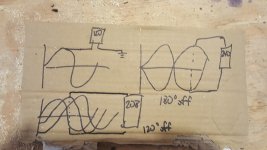CobyRupert
Super Member
Just got me to thinking. You can draw 15 amp off each side of a split receptacle fed with 14/3, like plugging in a kettle and a toaster oven, for a total of 30 amps (well, in a way) but couldn't draw 30 amps between the two legs as you would exceed the capacity of the 14 AWG. That, can become confusing.
Also (sometimes) confusing: If each side of the split receptacle is drawing 15 amps, (for a total of 30 amps passing through the breaker and receptacle), the return current in the neutral is (15 amps + 15 amps =) 0 amps.
(Some may insist it's really 15 + (-15)=0)
